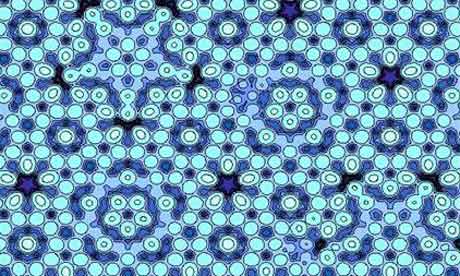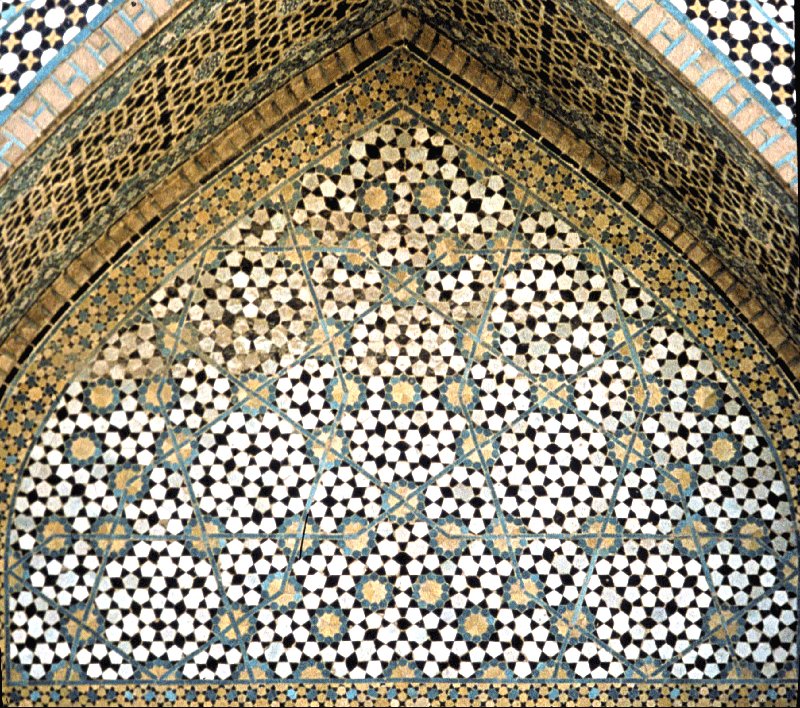The Royal Swedish Academy of Sciences has decided to award the Nobel Prize in Chemistry for 2011 to Daniel Shechtman of Israel Institute of Technology, Haifa, Israel "for the discovery of quasicrystals".
Quasicrystals
The long answer is: no one is sure.
But the short answer is straightforward:
a quasicrystal is a crystal
with forbidden symmetry.
Most crystals in nature, such as those in sugar, salt or diamonds, are symmetrical and all have the same orientation throughout the entire crystal. Quasicrystals represent a new state of matter that was not expected to be found, with some properties of crystals and others of non-crystalline matter, such as glass.
With five-fold symmetry, once thought to be impossible, they were first observed in 1984 in an aluminiun-manganese alloy (Al6Mn). Since then, quasicrystals have been found in other substances.
Quasi-crystals fill space with five-fold symmetry based on phi
A remarkable mosaic of atoms
In quasicrystals, we find the fascinating mosaics of the Arabic world reproduced at the level of atoms: regular patterns that never repeat themselves. However, the configuration found in quasicrystals was considered impossible, and Daniel Shechtman had to fight a fierce battle against established science. The Nobel Prize in Chemistry 2011 has fundamentally altered how chemists conceive of solid matter.
On the morning of 8 April 1982, an image counter to the laws of nature appeared in Daniel Shechtman's electron microscope. In all solid matter, atoms were believed to be packed inside crystals in symmetrical patterns that were repeated periodically over and over again. For scientists, this repetition was required in order to obtain a crystal.
When scientists describe Shechtman's quasicrystals, they use a concept that comes from mathematics and art: the golden ratio. This number had already caught the interest of mathematicians in Ancient Greece, as it often appeared in geometry. In quasicrystals, for instance, the ratio of various distances between atoms is related to the golden mean.
Stockholm: Daniel Shechtman of Israel won the 2011 Nobel Chemistry Prize Wednesday for the discovery of quasicrystals, "a remarkable mosaic of atoms", the Nobel jury said.
His research "has fundamentally altered how chemists conceive of solid matter," the jury said. "In quasicrystals, we find the fascinating mosaics of the Arabic world reproduced at the level of atoms: regular patterns that never repeat themselves," it added.
Quasicrystals have been found in certain forms of steel, which they reinforce like armour. His discovery was "extremely controversial," the Nobel committee said, pointing out that he was asked to leave his research group.
"His battle eventually forced scientists to reconsider their conception of the very nature of matter," it added.
Shechtman is a professor at Israel Institute of Technology in Haifa, where he holds the Philip Tobias Chair.
He will receive the 10 million Swedish kronor ($1.48 million, 1.08 million euros) prize at a formal ceremony in Stockholm on December 10, the anniversary of the death of prize creator Alfred Nobel.
Courtesy : Forbes, Gulfnews,physorg
http://about.me/prad

KERALITES - A moderated eGroup exclusively for Keralites...
To subscribe send a mail to Keralites-subscribe@yahoogroups.com.
Send your posts to Keralites@yahoogroups.com.
Send your suggestions to Keralites-owner@yahoogroups.com.
To unsubscribe send a mail to Keralites-unsubscribe@yahoogroups.com.
Homepage: www.keralites.net

![]()












No comments:
Post a Comment